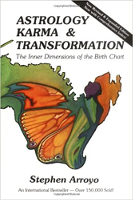
Image by Reimund Bertrams
For a tree's branches to reach to heaven,
its roots must reach to hell.
--Medieval alchemical dictum
The individual may strive after perfection
but must suffer from the opposite of his
intentions for the sake of his completeness.
--C.G. Jung
Each of the above quotations makes the same essential point, one that should always be remembered in any effort to understand astrological aspects: namely, that life itself requires us to encounter all manner of experience, the high and low, the light and dark, the good and bad, the easy and difficult in order that we may grow in awareness and become more whole. Many of us are familiar with the fact that an experience which seems particularly difficult or traumatic at the time is often the very experience which gives us the increased understanding which illuminates our life and motivates rapid growth for years to come.
Due to the particular type of consciousness which prevailed in England and the United States during the early part of the twentieth century, however, the great majority of astrological writings neglected to take this fact into account. In astrology books produced during that period, almost every factor in an individual's chart was regarded automatically to be good or bad depending upon how "easy" or "difficult" it might be for the person to express, satisfy, or integrate that part of his or her nature. A particularly narrow and distorted view of life thus developed in the minds of people who digested these early astrological writings, and -- unfortunately -- this narrow view still predominates today among many people active in the astrological field.
The Psychological Perspective of Astrology
In recent years, a reaction to this negative, distorted outlook has taken place, as many writers and lecturers have reformulated astrology in the light of the subtler, more psychological perspective that was initiated by Dane Rudhyar and Marc Edmund Jones.
As so often happens in any field when a reaction to an extreme approach sets in, many of the pioneers of a more positive, growth-oriented approach to astrology have tried to compensate for the faults of traditional astrology by going to the other extreme: i.e., by over-emphasizing the light side of life and neglecting to confront the darkness. What used to be regarded as "difficult" aspects in a chart are then sugar-coated with all sorts of idealized and flowery language, and the fact that some of these aspects indicate not only real problems for the person but also major defects or negative qualities in the character is ignored.
Being Realistic About Ourselves and About Astrology
It seems to me that it is time to be realistic about astrology, which means that we must become more realistic about ourselves and our view of life. Life is full of difficulties and problems. That is what makes it such a profound learning experience for the soul. If we view the birthchart as a comprehensive symbol of an individual's life potentials and life pattern, then that symbol must include indications of these crucial life problems, these areas of life wherein we can learn major lessons which further our growth.
What is not shown in the chart, however, is the attitude toward our cosmic inheritance and karma which we can consciously build and cultivate. Because the inner attitude cannot be determined from the birth-chart alone, the astrologer must be careful in any evaluation of a planetary configuration since it shows primarily the energy potential within that person, but not the specific manifestation of that energy as a predetermined fact. Such a realization calls for a period of exploratory questioning and dialogue in any astrological counseling session, in order that the counselor can get a feel for the specific attitudes and ideals which may be guiding the individual's use of his or her energies.
Since some people take difficulties and problems in stride, accepting them as a part of life, and since such people are sustained by an inner optimism and faith, what is shown in the chart as potentially troublesome is not always viewed by every person as a major problem. It may simply be seen as a fact of life, as an accepted part of the person's nature. If the counselor tries to over-emphasize the problematical side of such a symbolic configuration, it may seem to the person that the counselor is just stirring up all kinds of troublesome questions for no constructive purpose. In fact, this often happens in an astrological "reading" that is merely a one-sided performance by the astrologer.
"Difficult" Aspects Seen As Challenges Along the Way
If, on the other hand, the counselor views and explains the "difficult" aspects as challenges that the person will encounter in this lifetime, an energetic, positive-thinking person will be interested in knowing about such tests of his or her character, strength, and knowledge. And the more fearful, self-conscious person may then begin to view these major life questions in a new light. The main thing we should realize not only intellectually but also spiritually is that such challenges, difficulties, problems (call them what you will!) are necessary for health and should be welcomed as opportunities to learn what we need to know. As Jung writes:
Fear of fate is a very understandable phenomenon, for it is incalculable, immeasurable, full of unknown dangers. The perpetual hesitation of the neurotic to launch out into life is readily explained by this desire to stand aside so as not to get involved in the dangerous struggle for existence. But anyone who refuses to experience life must stifle his desire to live -- in other words, he must commit partial suicide.
(from Symbols of Transformation, CW Vol. 5, par. 165)
Surely no astrologer would want to believe that he or she is actually encouraging "neurotic" behavior in clients; and yet, the form of astrological practice that prompts the client to fear his destiny, to hesitate to act until the planets are in the right places, or to do anything possible to avoid "dangerous" or challenging situations is actually encouraging neurotic dependency on the astrologer and inhibiting the development of faith and self-confidence in the client. Perhaps in essence the traditional "difficult" aspects indicate areas of maximum stress and tension in the person's inner life, and this tension can also be welcomed with an open attitude. Again to quote Jung:
The greater the tension, the greater is the potential. Great energy springs from a correspondingly great tension between opposites.
I therefore prefer to use the following terms in categorizing aspects, rather than the traditional easy-hard, good-bad classifications:
DYNAMIC or CHALLENGING aspects: This term refers to those angles between planets that are usually called "stressful" or "inharmonious," including the square, opposition, quincunx (or inconjunct), some of the conjunctions (depending on the planets involved), and some of the semisquares, sesquiquadrates, and other minor aspects (depending on the harmony of the elements and signs involved). These angles correspond with the experience of inner tension and usually prompt some sort of definite action or at least the development of greater awareness in the areas indicated. Although the term "inharmonious" does apply to many of these aspects, this term is often misleading since it is possible for the individual to develop a relatively harmonious mode of expression for these energies by taking on responsibilities, work, or other challenges which are capable of absorbing the full intensity of the energy being released.
HARMONIOUS or FLOWING aspects: This term refers to those angles between planets that are usually called "easy" or "good," primarily including the sextile, trine, some of the conjunctions (depending on the planets involved), and some of the minor aspects (primarily depending on the harmony of the elements of the signs involved). These angles correspond with spontaneous abilities, talents, and modes of understanding and expression which the individual is able to utilize and develop with relative ease and consistency. These abilities constitute a set of steady and reliable psychological assets upon which the person may draw at any time. Although the individual may prefer to concentrate his or her energy and attention on the more challenging, dynamic aspects of life, these flowing aspects do represent the potential for developing extraordinary talents. But they contrast with the dynamic aspects in that they are more indicative of states of being and spontaneous attunements to established channels of expression; whereas the dynamic aspects indicate the need for adjustment through effort, definite action, and the development of new channels of self-expression.
Before getting into the subject of aspects in more detail, we might examine the question of why the dynamic angles in a chart seem to receive more attention in astrological studies than do the flowing aspects. Is it just a case of negative thinking wherein astrologers find masochistic pleasure in dwelling upon the more problematical side of life? Or is there some other explanation for this phenomenon?
I think that C.E.O. Carter clarifies this point when he writes in Astrological Aspects that the "inharmonious" aspects are easier to talk about due to the fact that these "have affinity with materiality and therefore manifest themselves more clearly and perceptibly." Carter's statement is supported by the fact that, until recently, the school of astrology known as Cosmobiology has almost totally ignored the harmonious aspects, preferring to use the dynamic aspects in their work; and anyone familiar with the underlying assumptions and orientation of most Cosmobiologists' work knows that they are primarily interested in events, major changes, obvious traumas, and, in general, the happenings of the material world rather than the individual's psychological attitude toward experience or its spiritual significance.
Awareness is the Key
I myself greatly emphasize the dynamic aspects, not because my orientation is the same as that of the Cosmobiologists, but because these angles reveal where one is being challenged to adjust oneself markedly and to grow through concentrated experience. And, since the majority of my astrological experience has come from interpersonal dialogues with clients (rather than solely from personal research, study, and working with my own chart), I have been drawn to the study of the positive potentials which are implicit in my clients' various life crises, and which are so often symbolized by the challenging aspects.
The important thing is that the individual practitioner be aware of his or her particular role, underlying philosophy and -- most of all -- the purpose each hopes to accomplish with the aid of astrology, If one's role is that of "counselor," whether formally through an established professional practice or informally through dealing chiefly with friends and relatives, one should be careful not to unnecessarily complicate the situations with which one is confronted day in and day out. For the archetypal human stories and problems are actually very few, and they go on repeating themselves in all our lives as intensely as if they had never happened before.
Counseling others in order to help them to deal with these archetypal problems is a highly demanding art, and our purpose should be that of aiding others to gain the perspective on their individual situations that will enable them to live life more fully through greater understanding.
Reprinted with permission of the publisher,
CRCS Publications, PO Box 1460, Sebastopol, CA 95473
Article Source
Astrology, Karma & Transformation
by Stephen Arroyo.
 This insightful and original book focuses on the understanding and use of astrology as a tool for spiritual and psychological growth. In contrast to traditional prediction-oriented astrology, this new approach to the most ancient of all sciences is based upon the law of karma and the urge toward self-transformation. It is especially pertinent for those whose interest in astrology is based on a recognition of its spiritual significance and its value for enhancing self-knowledge.
This insightful and original book focuses on the understanding and use of astrology as a tool for spiritual and psychological growth. In contrast to traditional prediction-oriented astrology, this new approach to the most ancient of all sciences is based upon the law of karma and the urge toward self-transformation. It is especially pertinent for those whose interest in astrology is based on a recognition of its spiritual significance and its value for enhancing self-knowledge.
Info/Order book. Also avaiable as a Kindle edition.
About the Author
 Stephen Arroyo is the author of numerous best-selling books on astrology, all of which have presented a type of astrology that is modern, innovative, and directed toward self-understanding. His widely acclaimed work has led to his being awarded the British Astrological Association's Astrology Prize, the International Sun Award by the Fraternity of Canadian Astrologers, and the Regulus Award. His books have been translated into 9 languages. He is internationally renowned as a pioneer of in-depth astrology, which his writings express with remarkable clarity. Stephen Arroyo is the author of Chart Interpretation Handbook; Astrology, Karma & Transformation; Astrology, Psychology, and the Four Elements; Relationships & Life Cycles; and more.
Stephen Arroyo is the author of numerous best-selling books on astrology, all of which have presented a type of astrology that is modern, innovative, and directed toward self-understanding. His widely acclaimed work has led to his being awarded the British Astrological Association's Astrology Prize, the International Sun Award by the Fraternity of Canadian Astrologers, and the Regulus Award. His books have been translated into 9 languages. He is internationally renowned as a pioneer of in-depth astrology, which his writings express with remarkable clarity. Stephen Arroyo is the author of Chart Interpretation Handbook; Astrology, Karma & Transformation; Astrology, Psychology, and the Four Elements; Relationships & Life Cycles; and more.
























